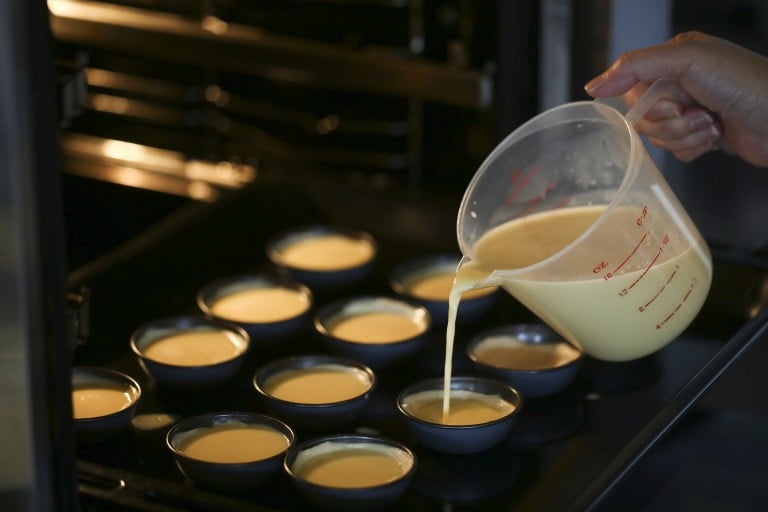
The only Portuguese egg tarts I’ve tasted have been based on the Macau version, so I’m calling these Macanese pasteis de nata. From what I’ve heard from friends who have eaten them in Portugal as well, they are slightly different from those found in Macau.
The egg tarts from Portugal and Macau are very different from the Cantonese daan taat, the variety you are most likely to find in Chinese bakeries in Hong Kong and abroad. The Cantonese type is delicate and pure – much like the cuisine – and the custard and pastry are smooth and pale.
Pasteis de nata, by contrast, are rougher looking – they have a pastry that’s medium- to dark-brown, and a custard that looks like it’s almost burnt in spots.
These tart shells are made using an unusual but extremely efficient technique: the dough is tightly rolled into a spiral, cut into pieces, placed in the tins with one of the cut sides up, then pressed into the contours of the tin with your thumbs. It is much easier than rolling out each piece of dough into a circle.
You need a sheet of puff pastry that weighs 225 grams (8 oz). It's okay if the pastry is a tiny bit less, but I wouldn't go less than 215 grams (7 ½ oz) because then, you'll be stretching the dough too much. If you can find it, use all-butter puff pastry. Keep the dough chilled at all stages of working with it. If it starts to soften, refrigerate it.
You need 12 pastry tins (preferably with smooth sides) that hold 50 grams (1¾ oz) each. It is essential to bake the tarts on a top-quality baking tray. Cheaper trays will buckle in the high heat of the oven, which will make the custard spill out of the tins. The tray that comes with the oven should be strong enough to withstand the heat, or use a tray with rolled edges. Round or square cake pans should also work, but you will need several of them.

Unwrap the puff pastry sheet, then roll it tightly into a spiral. Cut it into 12 equal pieces.

Dip one cut side of each piece in flour and shake off the excess, then place it, flour-side up, in the centre of a pastry tin.

Use your thumbs to firmly but evenly press the dough into the contours of the tin, to about 3mm (⅛ in) above the edge of the tin.
Place the prepared tins on a tray in the fridge and leave for 30 minutes, then freeze for at least 15 minutes.
Prepare the filling. Put the sugar and salt in a heatproof cup and add 50ml (3 tbsp and 1 tsp) of hot water. Microwave the cup, stirring about every 30 seconds, until the sugar is dissolved. (Or do this in a small pan on the stove.) Cool to room temperature.
Put the egg yolks into a mixing bowl. Stir in the sugar/salt water, then use a small sieve to sift the cornflour directly into the bowl. Whisk to combine.
Stir in the cream, milk and vanilla extract. Pour the mixture through a strainer into a liquid-measuring cup or another container with a pouring lip. Chill the mixture while heating the oven to 250 degrees Celsius (480 degrees Fahrenheit).
When the oven is hot enough, take the shells from the freezer and place them on a baking tray, or in round or square cake pan(s).

Gently but thoroughly stir the custard mixture, so the cornflour is evenly distributed. Divide the custards between the 12 shells. After pouring the custard into six shells, stir the mixture again, then fill the remaining tins.
Carefully place the pan(s) in the oven and bake for 12 minutes at 250 degrees Celsius/480 degrees Fahrenheit. Turn the heat to 200 degrees (390 degrees Fahrenheit) and bake for another eight to 10 minutes, or until the shells are medium brown and the custard is bubbling and browned in spots. Gently shake the pan(s): the custard (which will puff up) should be wobbly, but not liquid.

Take the pan(s) from the oven and cool the tarts. Serve them slightly warm, or at room temperature.
Leftover tarts should be reheated for five minutes in an oven preheated to 200 degrees Celsius (390 degrees Fahrenheit).